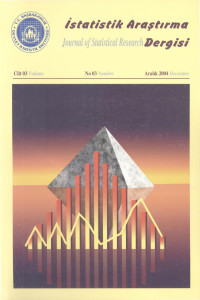Türkiye'de 1980-1985 Dönemi Bölgelerin İl Merkezi, İlçe Merkezi ile Bucak ve Köyler Bakımından Daimi İkametgaha Göre İç Göçler
Abstract
Bu çalışmanın amacı, Türkiye'de son yıllarda ve özellikle 1985 sonrası adeta "şiddetlenen" iç göç olayında şimdilik son "doğal dönem" olarak görebileceğimiz D.İ.E. 'nün 1980-1985 dönemindeki "Daimi İkametgaha Göre İç Göçler" yayınının içerdiği bazı bilgileri göz önüne sermektir. Çalışmada Türkiye beş bölgeye ayrılmış ve bu ayrışımla eşzamanlı olarak her bir bölge kendi içinde il merkezi, ilçe merkezi ile bucak ve köyler biçiminde yerleşim merkezlerine göre ele alınmıştır. Ele alınan bölge yerleşim merkezi türü durumları arasındaki göçler, geliş ve varış yerleri bakımından karşılaştırılmalı olarak incelenmiş, ayrıca çok bölgeli demografinin kullanıldığı Markov zinciri kavramından yararlanılarak uzun dönemde ülke nüfusunun durumlara göre dağılımı tahmin edilmiştir. Bunlara ek olarak daha sonraki çalışmalarda kullanılabileceği düşünülerek, durumlar arası geçişlere ilişkili sayılar, net göçler, bölge içine ve bölge dışına olan göçlere de yer verilmiştir. Bunun yanında kentleşme olgusu göz önüne alınarak, Türkiye nüfusunun yerleşim merkezi türleri arasındaki iç göçüne de değinilmiştir.
References
- ÇELEBİOGLU, S., (1988, Doktora Tezi, Gazi Üni., Fen Bil. Ens. ), Markov Zincirlerinde Durum Tahmini ve İç Göçe Uygulaması.
- ÇELEBİOĞLU, S., (1991), "Nedensel Matrisler ve İç Göçler", Gazi Üni. İktisadi ve İdari Bilimler Fakültesi Dergisi, 7(1-2),153-161.
- ÇELEBİOGLU, S. ve Bal, H., (1995), "Sürekli Parametreli Sabit Nedensel Markov Zincirleri ve İç Göçe Uygulanışı", Gazi Üni. Fen-Edebiyat Fak. Fen Bilimleri Dergisi, 5, 105-118.
- ÇELEBİOGLU, S., (1997), "İç Göçlerin Markov Zincirleriyle Modellenmesi Üzerine", Araştırma Sempozyumu '97 Bildirileri, T.C. Başbakanlık D.İ.E., 120-124.
- PLANE, D. A ve Rogerson, P. A. (1986), "Dynamic Flow Modelling with Interregional Dependency Effects: An Application to Structural Change in the U.S. Migration System", Demography, 23 (1), 91-104.
- PRICE, C. A, (1973), "Migration as a Means of Achieving Population Targets", Seminar on Demographic Research in Relation to Population Growth Targets, 1974 World Population Year, Commitee for International Coordination of National Research in Demography, Cicred.
- Daimi İkametgaha Göre İç Göçler, T.C. Başbakanlık D.İ.E., 1985.
The Internal Migration by the Permanent Residence Among the Regions in Turkey in View of Centers of Province, District and Subdistrict and Villages, in the Period 1980-1985
Abstract
In the last years, especially after 1985, there is nearly an "intensified” internal migration fact in Turkey. For this reason, the period 1980-1985 can be seen as a "last natural period" for the present. The aim of this study is to bring some knowledges included in "Internal Migration by Permanent Residence" of D.İ.E. into the open. In this study, Turkey is divided into five regions, and simultaneously each region is separated as centers of provinces, centers of districts and subdistricts and villages. The migrations among the states, the regions-kinds of centers of population are taken up comparatively in respect of origins and destinations of migrators and furthermore, taking the advantage of concept of Markov chains in which the multiregional demography uses the long-run distribution into states of Turkey's population is estimated. In addition, under the expectation to use for the future studies, it is also given place to the frequencies of transitions among the states, net migrations, the migrations into the regions and outside the regions. At the same time, the migrations among the kinds of centers of population are included as well, as a means of understanding the urbanization in Turkey.
References
- ÇELEBİOGLU, S., (1988, Doktora Tezi, Gazi Üni., Fen Bil. Ens. ), Markov Zincirlerinde Durum Tahmini ve İç Göçe Uygulaması.
- ÇELEBİOĞLU, S., (1991), "Nedensel Matrisler ve İç Göçler", Gazi Üni. İktisadi ve İdari Bilimler Fakültesi Dergisi, 7(1-2),153-161.
- ÇELEBİOGLU, S. ve Bal, H., (1995), "Sürekli Parametreli Sabit Nedensel Markov Zincirleri ve İç Göçe Uygulanışı", Gazi Üni. Fen-Edebiyat Fak. Fen Bilimleri Dergisi, 5, 105-118.
- ÇELEBİOGLU, S., (1997), "İç Göçlerin Markov Zincirleriyle Modellenmesi Üzerine", Araştırma Sempozyumu '97 Bildirileri, T.C. Başbakanlık D.İ.E., 120-124.
- PLANE, D. A ve Rogerson, P. A. (1986), "Dynamic Flow Modelling with Interregional Dependency Effects: An Application to Structural Change in the U.S. Migration System", Demography, 23 (1), 91-104.
- PRICE, C. A, (1973), "Migration as a Means of Achieving Population Targets", Seminar on Demographic Research in Relation to Population Growth Targets, 1974 World Population Year, Commitee for International Coordination of National Research in Demography, Cicred.
- Daimi İkametgaha Göre İç Göçler, T.C. Başbakanlık D.İ.E., 1985.
Details
| Primary Language | Turkish |
|---|---|
| Subjects | Statistics |
| Journal Section | Research Articles |
| Authors | |
| Publication Date | December 15, 2004 |
| Published in Issue | Year 2004 Volume: 3 Issue: 3 |


